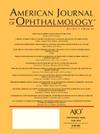诺布洛赫综合征的眼科和遗传特征:诺布洛赫综合征的眼部和遗传特征。
IF 4.1
1区 医学
Q1 OPHTHALMOLOGY
引用次数: 0
摘要
目的分析大队列Knobloch综合征的临床和遗传特征,重点关注视网膜脱离(RD)特征、手术结果和COL18A1基因变异。设计:回顾性、多中心介入/观察病例系列。研究对象34例(68只眼)临床和遗传学证实的Knobloch综合征患者。方法、干预或检测从三家机构收集数据,包括人口统计学、临床表现、手术技术和结果以及基因检测结果。手术成功定义为硅油去除后视网膜重新附着。对COL18A1基因进行基因检测以确定致病变异。主要结局指标主要结局包括RD的患病率和特征、手术成功率以及COL18A1致病变异的鉴定。结果诊断时的中位年龄为24个月,76%的病例有血缘关系。RD发生在50%的眼睛中,中位发病时间为2.5年。与黄斑孔(MH)相关的RD占57%,发病早期(中位年龄:11个月)。第一次手术后手术成功率为54%,再次手术后提高至69%。在69%的MH-RD病例中,使用Tenon's胶囊或羊膜移植使再附着率增加了一倍(82%对40%)。基因检测鉴定出14种COL18A1变体,包括9种新变体。结论knobloch综合征具有显著的诊断和手术挑战:早发性RD,易被忽视的小皮瓣状MHs,以及异常粘附的玻璃体视网膜界面。早期识别MH-RD并在手术中使用移植物可以改善解剖结果。而眼表型往往是病理性的,基因检测有助于确认诊断和指导咨询。了解这些临床和手术挑战可能会改善这种罕见疾病患者的预后。本文章由计算机程序翻译,如有差异,请以英文原文为准。
OPHTHALMOLOGICAL AND GENETIC PROFILE IN KNOBLOCH SYNDROME: Ocular and Genetic Features of Knobloch Syndrome.
PURPOSE
To analyze the clinical and genetic characteristics of Knobloch syndrome in a large cohort, with a focus on retinal detachment (RD) characteristics, surgical outcomes, and variants in the COL18A1 gene.
DESIGN
Retrospective, multicenter interventional/observational case series.
SUBJECTS
Thirty-four patients (68 eyes) with clinically and genetically confirmed Knobloch syndrome were included.
METHODS, INTERVENTION, OR TESTING
Data were collected from three institutions, including demographics, clinical findings, surgical techniques and outcomes, and genetic testing results. Surgical success was defined as retinal reattachment after silicone oil removal. Genetic testing was performed for the COL18A1 gene to identify pathogenic variants.
MAIN OUTCOME MEASURES
The primary outcomes included the prevalence and characteristics of RD, surgical success rates, and the identification of pathogenic variants in COL18A1.
RESULTS
The median age at diagnosis was 24 months, with consanguinity noted in 76% of cases. RD occurred in 50% of eyes, with a median onset of 2.5 years. Macular hole (MH)-related RD accounted for 57% of cases and presented early (median age: 11 months). Surgical success after the first procedure was 54%, improving to 69% after reoperation. The use of Tenon's capsule or amniotic membrane grafts in 69% of MH-RD cases doubles the reattachment rate (82% vs. 40%). Genetic testing identified 14 COL18A1 variants, including nine novel variants.
CONCLUSIONS
Knobloch syndrome presents significant diagnostic and surgical challenges: early-onset RD, small flap-shaped MHs that are easily overlooked, and an abnormally adherent vitreoretinal interface. Early recognition of MH-RD and the use of grafts during surgery can improve anatomical outcomes. While the ocular phenotype is often pathognomonic, genetic testing aids in confirming the diagnosis and guiding counseling. Understanding these clinical and surgical challenges may improve outcomes in patients with this rare disorder.
求助全文
通过发布文献求助,成功后即可免费获取论文全文。
去求助
来源期刊
CiteScore
9.20
自引率
7.10%
发文量
406
审稿时长
36 days
期刊介绍:
The American Journal of Ophthalmology is a peer-reviewed, scientific publication that welcomes the submission of original, previously unpublished manuscripts directed to ophthalmologists and visual science specialists describing clinical investigations, clinical observations, and clinically relevant laboratory investigations. Published monthly since 1884, the full text of the American Journal of Ophthalmology and supplementary material are also presented online at www.AJO.com and on ScienceDirect.
The American Journal of Ophthalmology publishes Full-Length Articles, Perspectives, Editorials, Correspondences, Books Reports and Announcements. Brief Reports and Case Reports are no longer published. We recommend submitting Brief Reports and Case Reports to our companion publication, the American Journal of Ophthalmology Case Reports.
Manuscripts are accepted with the understanding that they have not been and will not be published elsewhere substantially in any format, and that there are no ethical problems with the content or data collection. Authors may be requested to produce the data upon which the manuscript is based and to answer expeditiously any questions about the manuscript or its authors.

 求助内容:
求助内容: 应助结果提醒方式:
应助结果提醒方式:


